Fluoride
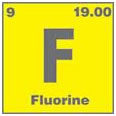 Use of fluorides for the prevention and control of caries is documented to be both safe and highly effective. Fluoride has several caries-protective mechanisms of action, including enamel remineralization and altering bacterial metabolism to help prevent caries.
Use of fluorides for the prevention and control of caries is documented to be both safe and highly effective. Fluoride has several caries-protective mechanisms of action, including enamel remineralization and altering bacterial metabolism to help prevent caries.
What is fluoride?
Fluoride is a compound that contains fluorine, a natural element. Using small amounts of fluoride on a routine basis can help prevent tooth decay. Research shows that community water fluoridation has lowered decay rates by over 50 percent, which means that fewer children grow up with cavities. Fluoride can be found as an active ingredient in many dental products such as toothpaste, mouth rinses, gels and varnish.
How does fluoride prevent cavities?
Fluoride inhibits loss of minerals from tooth enamel and encourages remineralization (strengthening areas that are weakened and beginning to develop cavities). Fluoride also affects bacteria that cause cavities, discouraging acid attacks that break down the tooth. Risk for decay is reduced even more when fluoride is combined with a healthy diet and good oral hygiene.
Will my child need fluoride supplements?
The pediatric dentist considers many factors before recommending a fluoride supplement. Your child’s age, risk of developing dental decay and dietary sources of fluoride are important considerations. Infant formulas contain different amounts of fluoride. Bottled, filtered and well waters also vary in the amount of fluoride they contain. Your pediatric dentist can help determine if your child is receiving -- and not exceeding -- the recommended amount.
How safe is fluoride?
Using fluoride for the prevention and control of decay is proven to be both safe and effective. Nevertheless, products containing fluoride should be stored out of the reach of young children. Too much fluoride could cause fluorosis of developing permanent teeth. Fluorosis usually is mild, with tiny white specks or streaks that often are unnoticeable. In severe cases of fluorosis, the enamel may be pitted with brown discoloration. Development of fluorosis depends on the amount, duration and timing of excessive fluoride intake. The appearance of teeth affected by fluorosis can be greatly improved by a variety of treatments in esthetic dentistry.
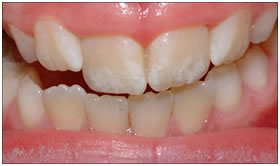 |
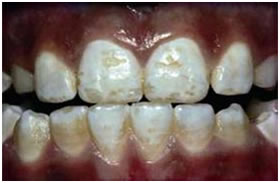 |
Mild fluorosis |
Moderate fluorosis |
What type of toothpaste should my child use?
Your child should use toothpaste with fluoride and the American Dental Association Seal of Acceptance. Brushing twice a day (after breakfast and before bedtime) provides greater benefits than brushing once daily. Parents should dispense toothpaste to prevent their young children from swallowing too much.
How much toothpaste should my child use?
For children under 2-years-old, use a smear (1) of fluoridated toothpaste. For those aged 2 to 5 years, a pea-sized amount (2) is recommended.
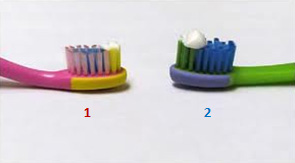
What is topical fluoride?
Topical fluoride is a preventive agent applied to tooth enamel. It comes in a number of different forms. A dentist places gels or foams in trays that are held against the teeth for up to four minutes. Topical fluoride is used to prevent and treat dental caries. Acidulated phosphate fluoride, or APF, preparations, which have been accepted by the American Dental Association since 1968, contain 1.23 percent fluoride ion (12,300ppm).
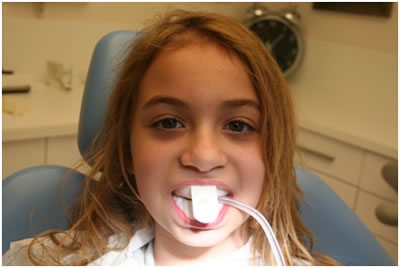
Topical fluoride application in the form of gel

Fluoride varnish is brushed or "painted" on the enamel. Varnish is especially useful for young patients and those with special needs who may not tolerate fluoride trays. Children who benefit the most from fluoride are those at highest risk for decay. Risk factors include a history of previous cavities, a diet high in sugar or carbohydrates, orthodontic appliances, and certain medical conditions such as dry mouth.
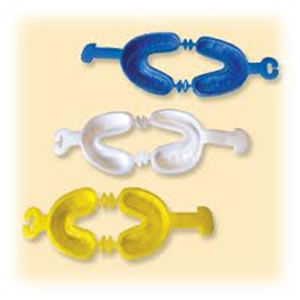
Fluoride trays
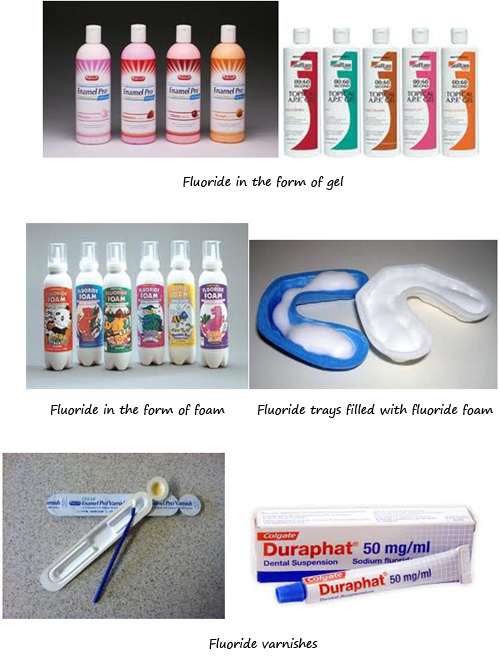
Fluoridated toothpastes:
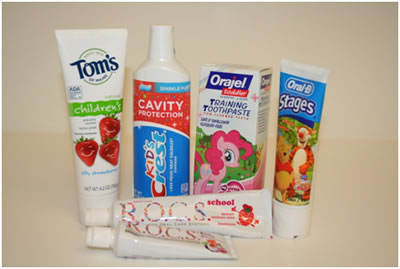
A toothpaste and a correct brushing action work to remove plaque, a sticky, harmful film of bacteria that grows on your teeth that causes caries, gum disease, and eventual tooth loss if not controlled.
The toothpaste containing fluoride makes the entire tooth structure more resistant to decay and promotes remineralization, which aids in repairing early decay before the damage can even be seen. Special ingredients in the dentifrice help to clean and polish the teeth and remove stains over time. Toothpastes help freshen breath and leave your mouth with a clean feeling.
Fluoride toothpaste contributes to the risk for enamel fluorosis because the swallowing reflex of children aged <6 years is not always well controlled, particularly among children aged <3 years Children are also known to swallow toothpaste deliberately when they like its taste. A child-sized toothbrush covered with a full strip of toothpaste holds approximately 0.75--1.0 g of toothpaste, and each gram of fluoride toothpaste, as formulated in the United States, contains approximately 1.0 mg of fluoride. Children aged <6 years swallow a mean of 0.3 g of toothpaste per brushing and can inadvertently swallow as much as 0.8 g. As a result, multiple brushings with fluoride toothpaste each day can result in ingestion of excess fluoride. For this reason, high-fluoride toothpaste (i.e., containing 1,500 ppm fluoride) is generally contraindicated for children aged <6 years. Instruct children under 6 years old in good rinsing habits in order to minimize swallowing. Supervise children as necessary until capable of using without supervision.
Fluoridated toothpaste should be used twice daily as a primary preventive procedure. Twice daily use has benefits greater than once daily brushing. Parents should be counseled on their child’s caries risk, dispensing an appropriate volume of toothpaste onto a soft, age-appropriate sized toothbrush, frequency of brushing, and performing/assisting brushing of young children. A ‘smear’ of fluoridated toothpaste for children less than 2 years of agemay decrease risk of fluorosis. A ‘pea-size’ amount of toothpaste is appropriate for children aged 2 through 5 years.
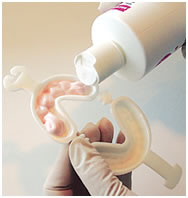 Professionally-applied topical fluoride treatments:
Professionally-applied topical fluoride treatments:
Professionally-applied topical fluoride treatments are efficacious in reducing caries in children with moderate or high caries risk. Two percent sodium fluoride (NaF; 9000 ppm) 1, 1.23% acidulated phosphate fluoride (APF; 12,300 ppm) solution or gel are the most commonly used agents for professionally-applied fluoride treatments. Some topical fluoride products are marketed with recommended treatment times of less than 4 minutes, but the majority of studies suggest that 4-minute applications are more efficacious.
Fluoride varnishes:
 Fluoride varnish is a protective coating that is painted on teeth with a brush. Over a period of time, the varnish releases fluoride which strengthens teeth and prevents tooth decay. Fluoride varnish is safe and can be used on babies from the time they have their first teeth. Only a very small amount of fluoride varnish is used. Wait until the next day to brush children’s teeth. After the fluoride varnish treatment wait at least 30 minutes, without any drinking or eating, and longer if possible. Give children soft foods and avoid hot, hard or sticky foods after the fluoride varnish application .
Fluoride varnish is a protective coating that is painted on teeth with a brush. Over a period of time, the varnish releases fluoride which strengthens teeth and prevents tooth decay. Fluoride varnish is safe and can be used on babies from the time they have their first teeth. Only a very small amount of fluoride varnish is used. Wait until the next day to brush children’s teeth. After the fluoride varnish treatment wait at least 30 minutes, without any drinking or eating, and longer if possible. Give children soft foods and avoid hot, hard or sticky foods after the fluoride varnish application .
Fluoride varnishes contain 5% sodium fluoride as their active ingredient, which translates to about 22,500ppm of fluoride ions. Varnishes are easily and quickly applied; they dry rapidly and will set even in the presence of saliva. Because they do not require the use of fluoride trays they are suitable for use in patients with a strong gag reflex. Due to the small amounts used and the rapid setting time there is only a small or negligible amount of fluoride ingested.
Fluoride Mouthrinses:
Fluoride mouthrinse is a concentrated solution intended for daily or weekly use. The fluoride from mouthrinse, like that from toothpaste, is retained in dental plaque and saliva to help prevent dental caries . The most common fluoride compound used in mouthrinse is sodium fluoride. Over-the-counter solutions of 0.05% sodium fluoride (230 ppm fluoride) for daily rinsing and solutions of 0.20% sodium fluoride (920 ppm fluoride) for weekly rinsing are available for use by persons aged >6 years.
Although no studies of enamel fluorosis associated with use of fluoride mouthrinse have been conducted, studies of the amount of fluoride swallowed by children aged 3--5 years using such rinses indicated that some young children might swallow substantial amounts. Use of fluoride mouthrinse by children aged >6 years does not place them at risk for cosmetically objectionable enamel fluorosis because they are generally past the age that fluoride ingestion might affect their teeth.
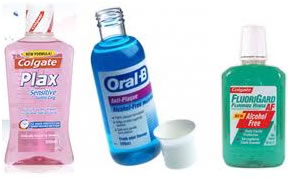
Fluoridated dental floss:
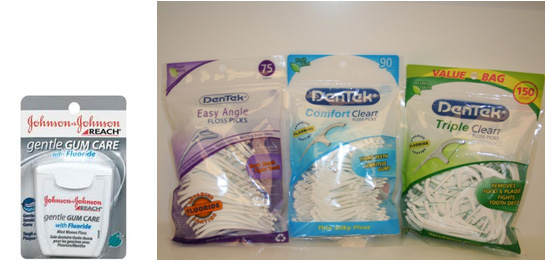
An alternate method of fluoride delivery for prevention or remineralization of interproximal lesions caries reduction is the regular use of fluoridated dental floss. Dental floss with fluoride not only cleans the interproximal tooth surface by physical removal of plaque colonies, but also reduces the risk of tooth decay. Patients flossing with fluoridated floss will be delivering the fluoride directly to the interproximal tooth surfaces.
Fluoride levels associated with the use of fluoride-impregnated floss on demineralized primary
enamel were significantly higher than levels associated with the use of a fluoride mouthrinse. One of the study showed that the number of interproximal areas harboring cariogenic microorganisms was reduced significantly after treatment with fluoride impregnated dental floss. Interproximal surfaces of teeth treated with fluoride impregnated dental floss acquired significantly (approximately three fold) more enamel fluoride than those treated with plain dental floss. Use fluoridated dental floss to clean between your child’s molar teeth until your child is about 10 years old.
Sources
http://www.aapd.org/media/Policies_Guidelines/G_FluorideTherapy.pdf
Chaet R, Wei SH., The effect of fluoride impregnated dental floss on enamel fluoride uptake in vitro and streptococcus mutans colonization in vivo.ASDC J Dent Child. Mar-Apr;44(2):122-6. 1977
Johnna Jorgensen, Mansour Shariati, Carol P. Shields, MS David P. Durr,Howard M. Proskin: Fluoride uptake into demineralized primary enamel from fluoride-impregnated dental floss in vitro, Pediatric Dentistry 1989 March Vol 11 number 1
http://cdc.gov/mmwr/preview/mmwrhtml/rr5014a1.htm





